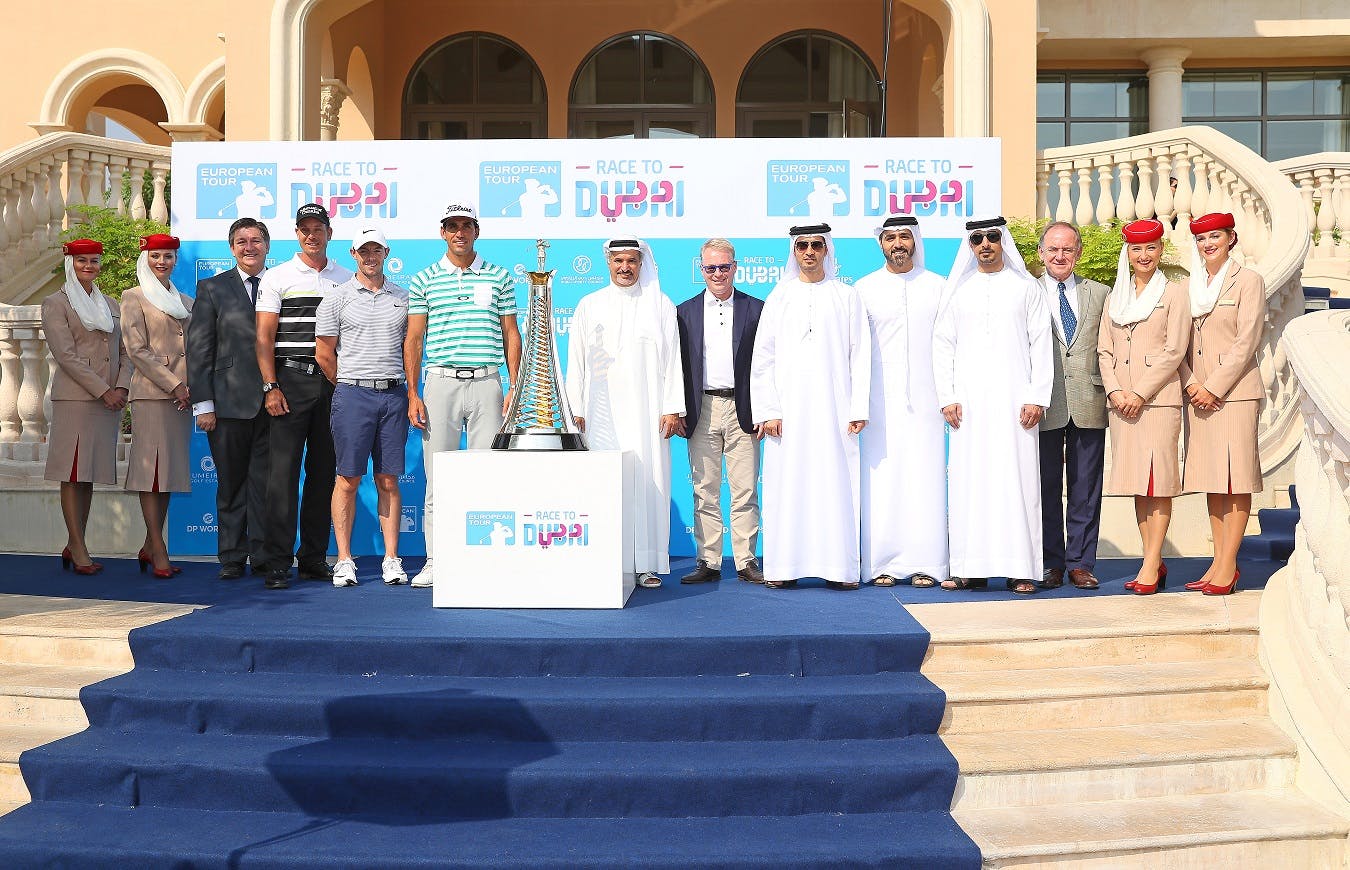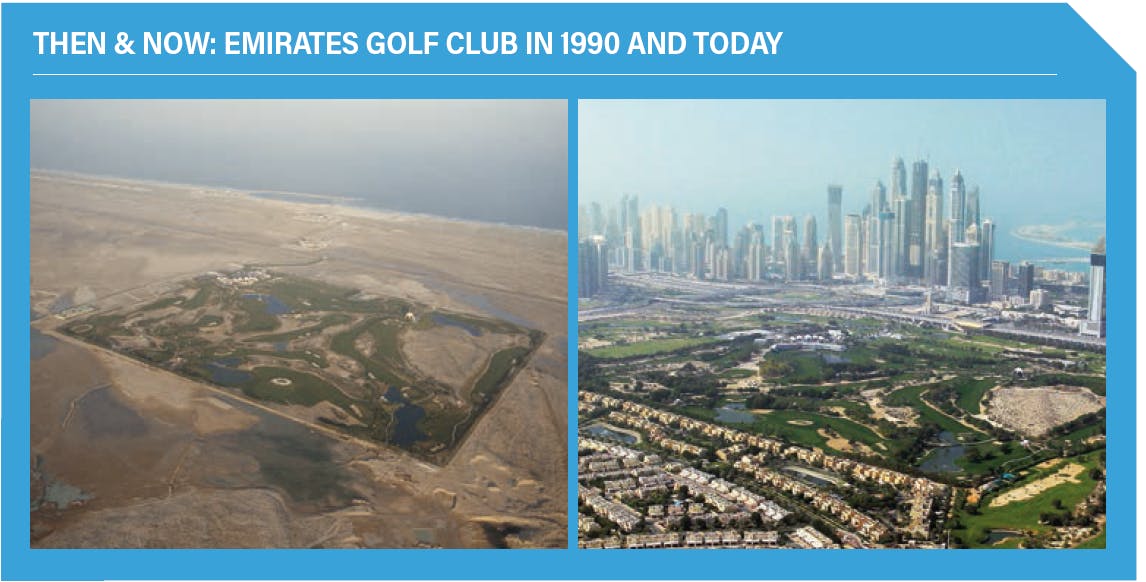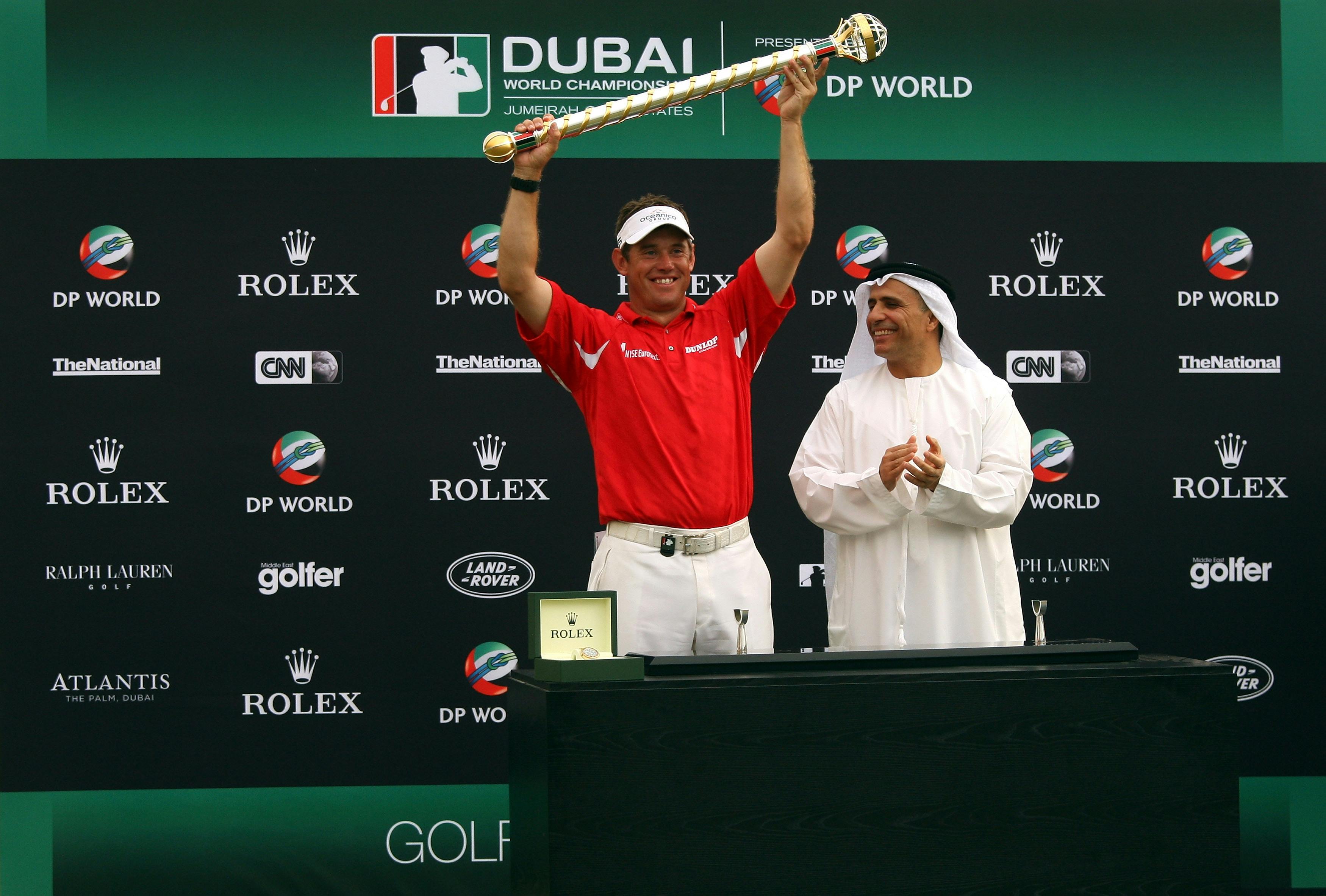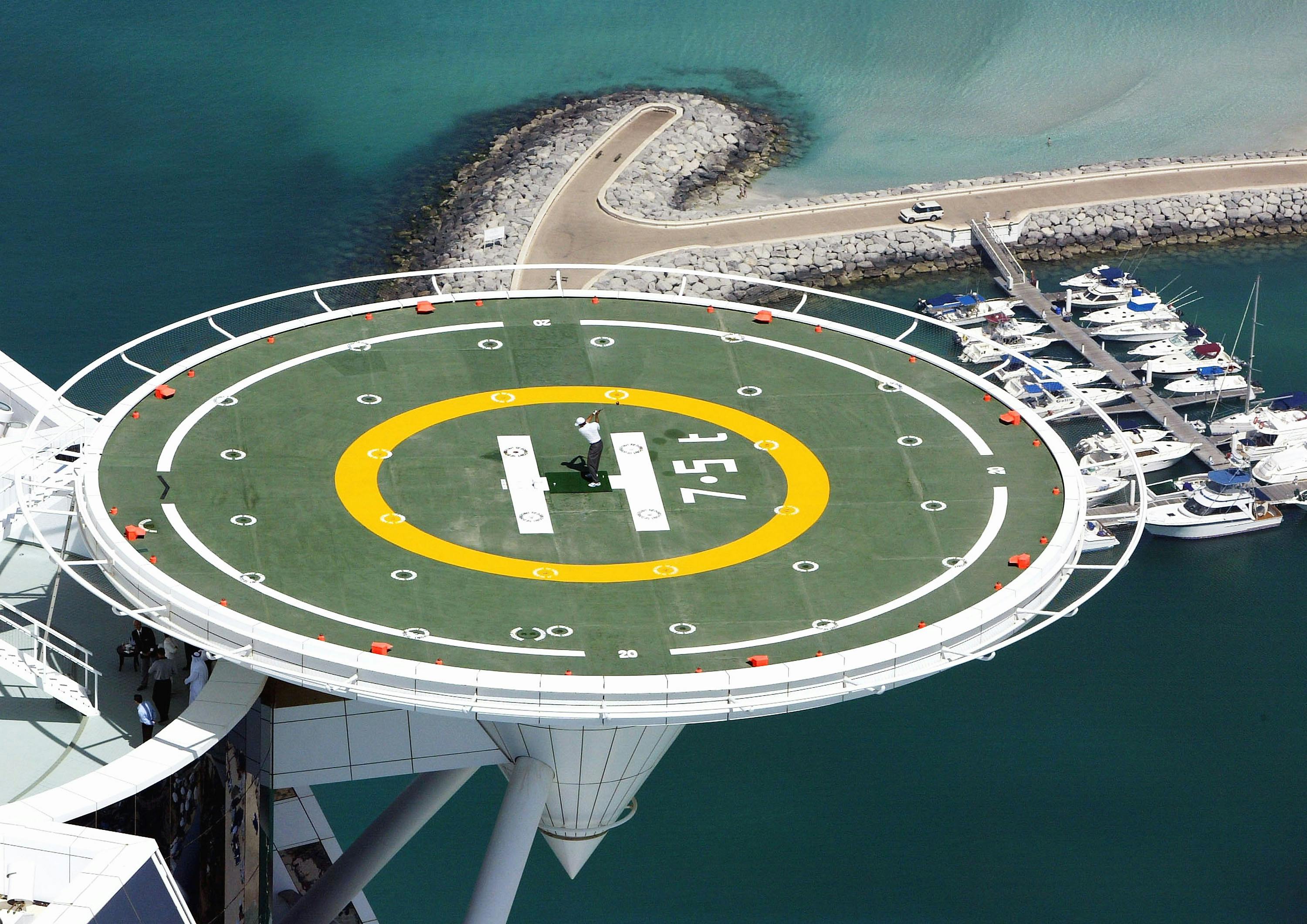HENRIK STENSON’S VICTORY in this year’s European Tour Race to Dubai – which crowns the most successful player of the year – may not have been sealed by his best performance of the season but, coming in the prestigious DP World Tour Championship Final at Dubai’s Jumeirah Golf Estates, was a home-from-home win for the Swedish star.
Stenson, who had previously won both the DP World Tour Championship and Omega Dubai Desert Classic, has a home at Jumeirah Golf Estates and has been an official ambassador for the club. Likewise, Rory McIlroy, who missed out on the top Race to Dubai honour this year, has been visiting Dubai since the age of 15 and played his first European Tour tournament at the 2007 Omega Dubai Desert Classic as an amateur. Just two years later he claimed his first Tour title at the same event.
Speaking in November at the unveiling of the new Race to Dubai logo, which symbolically combines the European Tour and Dubai logos, he spoke of his association with and affection for Dubai. McIlroy, winner of the 2015 Race to Dubai and DP World Tour Championship, has a home in Dubai and hones his skills for the new season each year at the Butch Harmon School of Golf at The Els Club. He said: “Dubai has always been a special place for me. I made my first cut here on the European Tour and then went on to have my first win as a professional in the Omega Dubai Desert Classic. It’s been a pretty amazing journey since then – and throughout all the success I have enjoyed around the world, Dubai has been a constant part of the story for me, my family and friends. I have been lucky enough to win the DP World Tour Championship twice as well as three Race to Dubai titles and I’m a resident here as it is the perfect place to come and work on my game. It’s become a real home from home for me so I always love coming back.”
Dubai has a close relationship with many leading players including Rafa Cabrera Bello – who has a home there – Thomas Bjorn, Colin Montgomerie and Ernie Els to name a few. And now there is a new generation of young players rising through the ranks having practiced and played on Dubai’s courses.
This year’s DP World Tour Championship Final was won by 22-year-old Englishman Matthew Fitzpatrick, who said: “Dubai is home to some of the most impressive golf facilities in the world and has made a massive impact on European golf in recent years.” The players’ sentiments sum up golf ’s strong relationship with Dubai but, as with all good relationships, this is a two-way street.
Golf has been played in Dubai in one form or another throughout its short but vibrant history. And today it plays an important economic role as a key pillar of the emirate’s burgeoning sports sector, as a significant driver of tourism and in promoting Dubai and its companies through the high-profile professional tournaments staged on its major courses. The sport has become part of the life of the emirate and of Brand Dubai itself.
According to a report compiled by Deloitte, the gross expenditure of golf in Dubai is $270m per year, accounting for 25 per cent of the total expenditure on sport in the emirate. Its direct economic impact is $131m per year and 1,800 people work in the sector, most in Dubai’s nine clubs, which host 440,000 rounds of golf every year – 40,000 of them accounted for by some 16,000 visitors from overseas.

In 2013 Dubai Tourism, the body responsible for the emirate’s tourism industry, set a target of attracting 20 million visitors by the time Dubai hosts the World Expo in 2020. In 2012 the figure was in the region of 12 million but, with 15 million recorded last year, the graph is heading in the right direction and sport – and golf in particular – is continuing to play its part.
Peter Walton of the International Association of Golf Tour Operators, which works with governments and the golf industry in countries around the world, says Dubai is well placed to build its golf visitor numbers because it has built a strong and resilient market position.
“There are 56 million golfers worldwide and 25 per cent of registered players take a holiday where golf is the main driving factor,” he said.
“That doesn’t happen with other sports except for skiing and perhaps diving.”
And golf tourists tend to be more affluent and influential. In fact, golf visitors tend to spend onefifth more than average travellers on their visits, complementing their spend on golf itself with dining and entertainment.
“The pattern can be seen in the USA where currently 11 per cent of adults play golf but golf accounts for 24 per cent of all travel spend. That is mirrored in other markets around the world and, in a MasterCard survey of Asian markets, travel, dining and golf were top of the aspirational spending list. That is why people bother with golf travel,” Walton explained.
And Dubai, with its golf-friendly climate and a location that makes it a short or medium-haul flight from a major chunk of the world’s population, seems ideally placed to ride the crest of the wave.
For while, as Walton explains, golf is not immune to the world’s financial woes, golf travellers are drawn from the “avid golf community who won’t be denied their fix.”
“The fact is that most ‘happy hackers’ won’t want to travel medium to long haul and spend $200 on a round of golf, but the avid players won’t be put off and Dubai’s positioning at the top end of the golf market contributes to stability.
“All Dubai’s courses are what we call ‘export ready’ and tourist friendly. That means they offer the quality of golf and facilities that people are willing to travel to and pay for. It is all about Quality; Access; Price and Promotion because the distance people are willing to travel is directly related to the quality of the golf,” he said.
Add the quality of courses, practice facilities and clubhouses to some of the world’s most renowned hotels, big-name fine dining restaurants and an exciting entertainment scene that now includes events at the iconic Dubai Opera, and Dubai has all the ingredients of a golf super-hub in one of the most accessible parts of the world.
Dubai has seen significant investment in golf courses, academies and facilities since entering the golf market back in 1988 with the launch of the original Desert Miracle – Emirates Golf Club – a Dubai institution that would ultimately revolutionise the European Tour and put the UAE on the sporting map.
Every subsequent project has had both the budget and the blank canvass required to create something special. Dubai’s golfing expansion is intrinsically linked to the overall development, expansion and diversification of the emirate and its courses and associated facilities share the hallmark of innovation and quality on which Dubai has built its global reputation.
Dubai currently has 11 world-class courses at nine clubs with others, including the Trump International, due to come on stream to boost capacity and increase choice.
Among them, Jumeirah Golf Estates, Arabian Ranches, the Address Montgomerie Golf Resort & Spa and the Els Club Dubai are all located within upscale residential communities. Older courses such as Emirates Golf Club, Dubai Creek and the JA Jebel Ali Golf Resort have much smaller real estate components, but Dubai has done a wonderful job to ensure that the real estate does not detract from the golfing experience.

As with other sports, Dubai takes a progressive approach to golf and is moulding facilities to meet the needs of players now and in the future. For example, three of Dubai’s clubs offer Night Golf, meeting the demands of the daytime schedules of busy players and providing a vivid and very different golfing experience.
Today Dubai hosts three flagship golf tournaments: The Omega Dubai Desert Classic, the season-ending DP World Tour Championship and the Ladies European Tour’s finale, the Omega Dubai Ladies Masters. The Omega Dubai Desert Classic is where it all began in 1989, with the first ever European Tour event to be held outside the continent’s borders. Dubbed the ‘Major of the Middle East’, the Majlis course has grown to be one of the most cherished venues on the tour and the famous trophy has been hoisted by many of the game’s legends, from Tiger Woods to Seve Ballesteros, Ernie Els, Colin Montgomerie and Rory McIlroy. Meanwhile the DP World Tour Final, where the winner of the Race to Dubai is crowned, has been described by European Tour chief executive Keith Pelley as its ‘flagship tournament’. It has the biggest purse for a stand-alone European Tour event and in its seven-year history it has built a reputation for producing nail-biting drama on the closing stretch.
The Omega Dubai Ladies Masters is the most prestigious tournament on the Ladies European Tour and has been won three times by China’s first ever major champion, Shanshan Feng, in recent years. But Dubai’s rich association with hosting professional tournaments does not end here. As recently as 2015, the Asian Tour staged the Dubai Open at The Els Club to mark its season climax, and the European Challenge Tour held its finale at Al Badia in 2013 and 2014. The MENA Golf Tour (set up by golf in Dubai to help Arab talent gain a foothold in the professional game) hosts two Dubai events, at Dubai Creek Golf & Yacht Club and The Els Club Dubai.

Dubai’s top professional golf tournaments boast an array of sponsors, from global brands that have had long associations with the sport to local companies, many of whom have supported their chosen event from year one. Two of the world’s biggest watch brands are prominent, with Rolex partnering the DP World Tour Championship and Omega reprising the role of title sponsor for both the Omega Dubai Desert Classic and the Ladies Masters. The two German automotive giants, BMW (DPWTC) and Mercedes (ODDC) also have long-standing relationships, and perhaps unsurprisingly, Emirates maintains its widespread commitment to local and international sport at Jumeirah Golf Estates. Dubai Duty Free is committed to all three tournaments.
Of course, Dubai’s climate plays a key role in its appeal as a golf destination. While Dubai gets more ‘weather’ than people tend to give it credit for, and conditions do vary from year to year, you can usually rely on cool mornings and warm afternoons during winter, warm to hot days with minimal humidity during the shoulder season and very hot and humid days during summer.
The key point is that Dubai offers golf 365 days per year. The courses are in peak condition during the winter months, when the cool season grasses come through and the turf responds to ideal growing conditions, but the widespread shift to paspalum has seen most courses fare well over the hot summer. In winter, daytime temperatures tend to peak around 27 degrees centigrade, with anything between 26 and 35 possible over the shoulder months and temperatures of higher than 40 degrees the norm during July, August and September. For over half of the year, Dubai offers reliable weather that is close to ideal for golfing.
Peter Dawson, president of the International Golf Federation, who has studied golf in Dubai from all angles, believes these are exciting times for both the emirate and the sport itself.
“Dubai is, in many ways, already a ‘must’ destination for golfers,” he said.
“I’ve never been anywhere in the world where there is such a high percentage of courses which are really world class and the clubhouses and associated facilities are second to none.

“Dubai is now making it easier for tourists to arrange to play there. After all Dubai is a young and vibrant place and golf can be used to bring more tourists here. Part of that will be done by telling the story of Dubai through its professional tournaments which are already very strong. The Race to Dubai is a great asset and there is a huge potential to tell the Dubai story week-by-week through the year by activating it even more strongly.”
As head of the sport’s International Federation, Peter Dawson is naturally focused on increasing participation levels among the local population as well as helping Dubai fulfil its potential as an international destination.
“We want to do whatever we can to help the Emirates Golf Federation to stimulate participation,” he explained.
With the stars of the global game making frequent visits to Dubai and the MENA Golf Tour now set up to offer a competitive platform in which local players can propel their games to the next level, there is a palpable sense that the time is now for Emirati nationals to embrace the sport. In 2016, a collaboration between the Emirates Golf Federation and Golf DXB led to the formation of the most comprehensive Emirati recruitment drive ever conducted in the UAE. The result was that this year, 150 local children joined a junior development programme, and there are between 40 and 50 who attend sessions at Meydan Golf on a regular basis.
Encouraging Emirati participation has been a challenge for the game’s national authorities but with the Emirati tour professional, Ahmed Al Musharrekh, determined to inspire kids to follow in his footsteps and a greater level of organisation among the game’s various bodies, there are encouraging signs for future growth in this area.